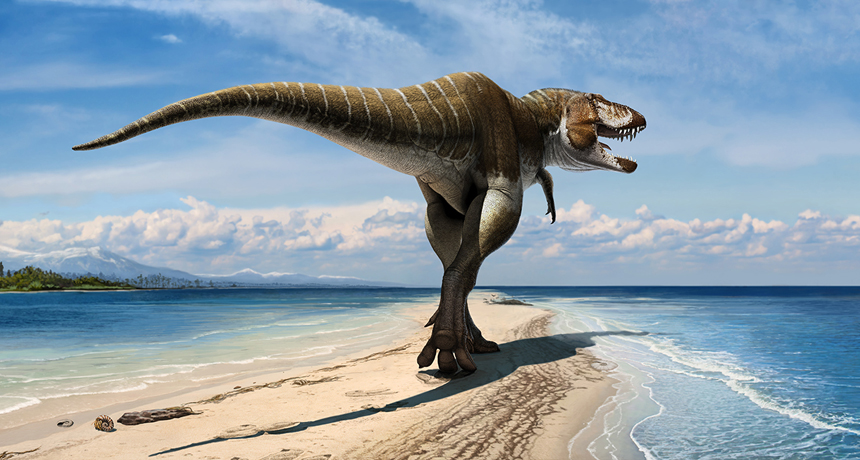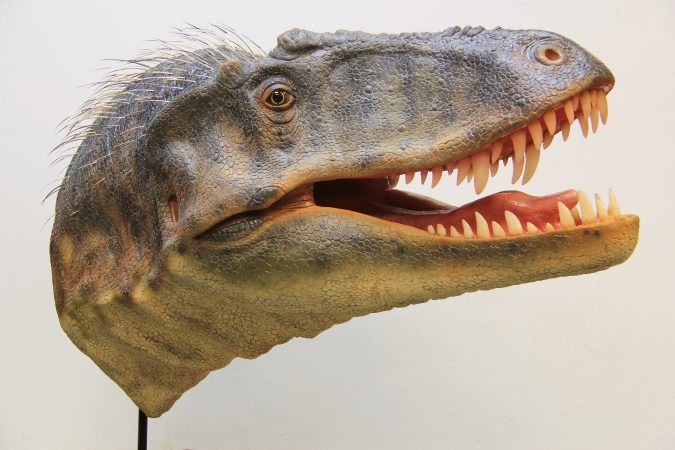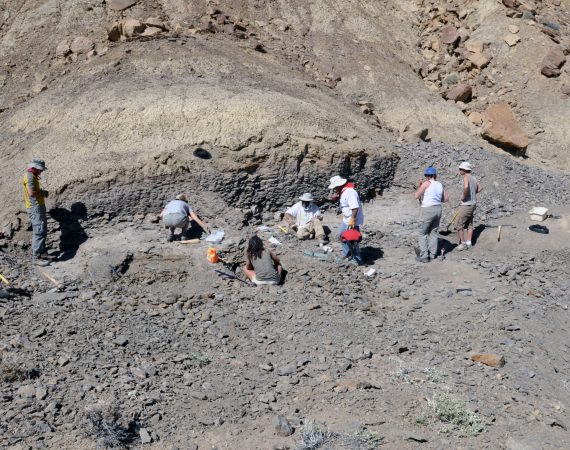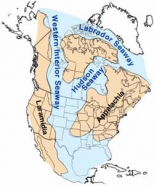King of Gore
At a site in southern Utah, paleontologists unearthed the oldest T. rex ancestor

Artists’ portrayal of Lythronax looking out into the Western Interior Seaway at Utah’s Wahweap site some 80 million years ago.
Andrey Atuchin
By Janet Raloff
Some 90 million years ago, two-footed meat-eating dinosaurs began undergoing big changes. They were adapting to conditions in what is now the western United States. Best known among this line would be the fearsome Tyrannosaurus rex. But some of its ancestors also would have cut a mean swath through the countryside. Consider Lythronax argestes (LYE-thro-nax Ar-GESS-tees). A newfound addition to the family, it’s the earliest. And its Greek name says it all: Gore King of the Southwest.
An imposing 8 meters (roughly 24 feet) from snout to tail, the juvenile that’s been unearthed truly would have been the top predator of its ecosystem — if you ignore the 12-meter (40 foot) gator that patrolled coastal waters. Lythronax adults could have topped out “at maybe 35 feet long,” notes Mark Loewen. That would make it about 80 to 85 percent as big as a T. rex, this University of Utah scientist explains. He is one of five paleontologists who introduced the new dino through a Nov. 6 paper in PLOS One.
With forward-placed eyes, Loewen explains, “this was the first tyrannosaur that could look you in the eye — with both eyes!” Its stereo vision would have offered it a distinct advantage in finding the huge quantities of prey needed to fuel its 2.5-ton body. The sharp teeth in its meter-long head could have sliced through that prey handily. With some front choppers almost 13 centimeters (5 inches) long, “you wouldn’t have wanted to meet it in a dark alley,” Loewen quips.

Scott Richardson of the U.S. Bureau of Land Management discovered a single specimen of the new dinosaur in 2009. He had been bone-hunting with a co-worker when they ran across a leg sticking out of the ground. The animal’s nose bone sat nearby atop the ground.
Quickly, Richardson phoned the University of Utah team to share his news. At the time, Loewen recalls, “We were actually at lunch in a burger joint.” Richardson said he’d run across a raptor-like theropod fossil in the Wahweap Formation. It’s a fossil-rich site within the Grand Staircase-Escalante National Monument. Richardson’s agency manages this protected land. It spans 770,000 hectares (1.9 million acres) across high desert in south-central Utah.
The Grand Staircase-Escalante National Monument “is the last great, largely unexplored dinosaur bone yard in the lower 48 states,” observes coauthor Scott Sampson. He also works at the University of Utah in Salt Lake City.

It took months to unearth the fossil remains of this new reptile. Recovered bones include parts of a skull, leg, hips and tail.
Especially exciting, Loewen says: “It came from an age from which we had no tyrannosaur fossils.” And as he and his colleagues pored over the bones during the next few years, he said they soon realized “its features were more like T. rex than like other tyrannosaurs that came just after it” in geologic time. As such, it seems a likely close ancestor to the formidable T. rex.
A surprise find
The tyrannosaur’s remains were found at a site that is now high and dry. But when this reptile thundered across the landscape, 80 million years ago, the region was swampy. It sat on the western edge of the Western Interior Seaway. This massive body of water cut through North America, from top to bottom. Laramidia, the western landmass, ran from what is now western Mexico up into Alaska. And it’s where the new dino had evolved.

The seaway separated various Laramidia species from others in North America for millions of years. Research on the new species and others unearthed from around the same time suggest Lythronax and other tyrannosaurids began diverging into different species between 95 million and 80 million years ago. This was “a time when North America’s interior sea was at its widest extent,” explains Randall Irmis. Like Sampson, he works at the University of Utah and coauthored the new paper.
Gradually, the seaway’s water receded. The land dried. Dinosaurs now could range widely. But owing to the different environments and climate conditions under which they had been living, many had evolved into a host of different — but related — species, Irmis’ team concludes.
The surprise was not that a tyrannosaur might have roamed Laramidia, Loewen says. Plenty of smaller kin with really long noses had been hunting there since the Jurassic Era, which began more than 100 million years earlier. But none were the specialized big tyrannosaurs. Now that Lythronax has turned up, paleontologists want to know what bridge species might link those tiny ones with their Big Daddy descendants.
“That’s our next step,” Loewen told Science News for Students. “What we learned from this paper is that a lot of evolution took place before 80 million years ago” in this line of dinosaurs. That wasn’t known, he explains. “Now we’ll be looking for the next specimens to teach us even more.”
Indeed, adds teammate Philip Currie of the University of Alberta in Edmonton, Canada: “Lythronax is a wonderful example of just how much more we have to learn about the world of dinosaurs.”
Power Words
Cretaceous Period A geologic time period that included the end of the Age of Dinosaurs. It ran from roughly 145.5 million years ago until 65.5 million years ago.
fossil Any preserved remains or traces of ancient life. There are many different types of fossils: The bones and other body parts of dinosaurs are called “body fossils.” Things like footprints are called “trace fossils.” Even specimens of dinosaur poop are fossils.
geology The study of Earth’s physical structure and substance, its history and the processes that act on it. People who work in this field are known as geologists. Planetary geology is the science of studying the same things about other planets.
Grand Staircase-Escalante National Monument A huge patch of public land spanning nearly 1.9 million acres (770,000 hectares) in the western United States. It gets the first part of its name from the Grand Staircase of cliffs and terraces that cross the rugged Kaiparowits Plateau. The second part of its name traces to its Escalante River Canyons. Owing to its being a rich source of dinosaur fossils, this monument has become popular among geologists, paleontologists, archeologists and others interested in scientific research.
Jurassic Lasting from about 200 million to 145.5 million years ago, it’s the middle period of the Mesozoic Era, a time when dinosaurs were the dominant form of life on land.
landmass A continent, large island or other continuous body of land.
Laramidia The western island continent created during the Late Cretaceous period when the Western Interior Seaway split the continent of North America into two parts.
paleontology The branch of science concerned with ancient, fossilized animals and plants.
theropod A meat-eating dinosaur of a group whose members are typically bipedal (walk on two legs) and range from small and delicately built to very large.
tyrannosaur A line of meat-eating dinosaurs that began during the late Jurassic Period, about 150 million years ago. These theropod species persisted into the late Cretaceous Period, about 65 million years ago. The best known member of these species: the late Cretaceous’ Tyrannosaurus rex, a 12-meter (40 foot) long top predator of its time.
tyrannosaurid Any of the large, two-footed therapod tyrannosaurs living in the Cretaceous Period.
Western Interior Seaway This shallow marine sea, sometimes called the Cretaceous Seaway, split North America into two landmasses: Laramidia to the West and Appalachia to the East.







